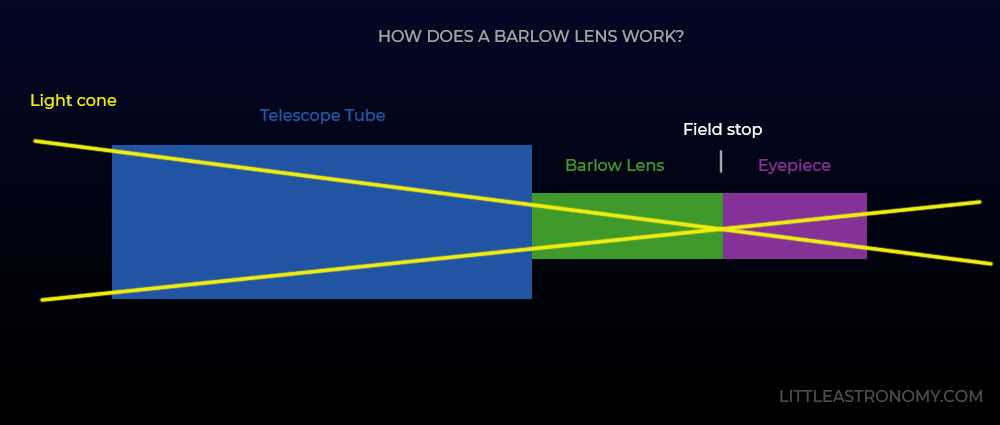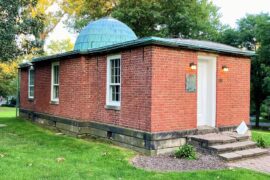What is a Barlow lens
Barlow lenses are the most versatile telescope accessory you can get. A Barlow lens is a device you can use in a telescope before an eyepiece to increase the magnification you would normally get. They do this by decreasing the focal length of your optical chain by the number of times they are rated for (1.5x, 2x, 3x, etc).
Barlow lenses are named after their inventor, Peter Barlow, a British physicist, and mathematician born in the late 1700s.
Barlow lenses are typically made of three or four inner lenses or mirrors aligned to reduce optical errors. There are Barlows made of a single lens, but even though their price can be very attractive, you generally want to stay away from them as they’ll generate a worse image.
If you come from the photography world, Barlow lenses are the equivalent to a teleconverter in a telescope’s optical chain.
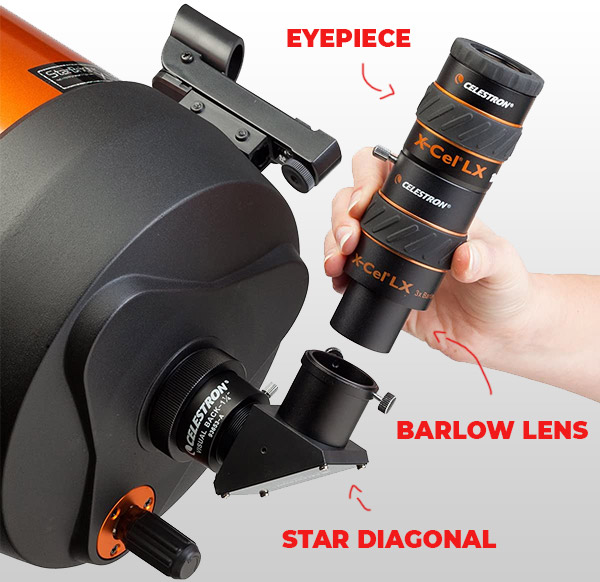
How does a Barlow lens work
The idea for Barlows is quite simple, but also very clever. The first thing you need to know is that the formula for magnification is the result of dividing the telescope’s focal length by the eyepiece’s focal length. That means that If you decrease the eyepiece’s focal length, you can increase the magnification by the same amount. The other option would be to increase the tube´s focal length, but that would mean having to buy a different telescope. This is why Barlow lenses are such handy and cost-effective accessories.
Barlow lenses work by effectively reducing the eyepiece’s focal length by the rated amount.
But how can you reduce the focal length by adding another element to the optical chain? wouldn’t that increase it?
That’s an understandable question, but the answer is no. What you need to do to reduce the focal length is to make more acute the cone of light that is coming from the telescope’s lens, thus simulating the effect of a telescope with a greater focal length. This is a much easier concept to understand visually so take a look at the following figure.
Please note this is an oversimplification of the process, but it should give you a good idea of how Barlow lenses work on the inside.
Magnification Sizes
Barlow lenses come in one of the following magnification sizes or rates.
- 1.25x
- 1.5x
- 1.75x
- 2x
- 3x
- 4x
- 5x
Choosing which magnification is best for you is going to depend on the eyepieces you want to use with it.
Because the Barlow multiplies the magnification by its rate, when you pair your eyepieces with a Barlow, is will be like having an eyepiece with the focal length of the eyepiece’s length divided by the rate. A few examples:
- Pairing a 10mm eyepiece with a 2x Barlow will be like having a 5mm eyepiece (10 / 2 = 5)
- Pairing a 12mm eyepiece with a 1.5x Barlow will be like having a 8mm eyepiece (12/ 1.5 = 8)
- Pairing a 25mm eyepiece with a 4x Barlow will be like having a 6.25mm eyepiece (25 / 4 = 6.25)
So if you have a 40mm eyepiece, a 20mm, and a 10 mm, getting a 2x Barlow lens wouldn’t be too useful because it would be like having 20mm, 10mm, and 5mm eyepieces, two of which you already own. Now, if you were to get a 1.25x Barlow, with those same eyepieces, you would have access to the focal lengths of 32mm, 16mm, and 8mm, which gives you a much better range and effectively doubles the number of magnification options you have.
The 4x and 5x Barlow lenses are usually used only for astrophotography.
Pros and cons of Barlow lenses
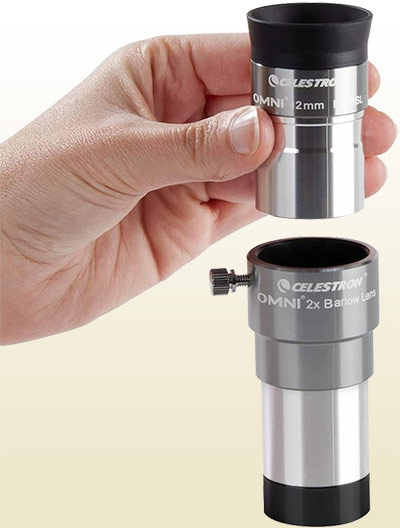
Let’s take a look at the advantages and disadvantages of adding a Barlow lens to your setup.
Pros
- Save money on eyepieces. A Barlow lens will effectively double the number of magnification levels you have access to with a single purchase, thus saving you money on the long run as you will not need to purchase as many eyepieces.
- Increased magnification. This is their primary use. Increasing the magnification you get through your lens.
- Get access to more magnification levels. If you plan your Barlow purchase well, you can cover a lot of focal lengths/magnifications you didn’t have access to previously.
- Save space. This can be an underrated benefit of Barlows if you travel or go camping for your stargazing. Carrying fewer equipment matters a lot, and a few Barlows will save you from carrying a huge case of eyepieces.
- Increased back focus. A side effect of Barlow lenses is the increase in back focus (the distance between the telescope to the end of the optical setup). Due to their design, some telescopes like Newtonians/reflectors, have very little back focus. Barlow lenses can help you increase it. Why would you want to do that? Well, some accessories like binoviewers require a larger back focus to work properly.
- Maintain eye relief. Another benefit of Barlow lenses is the ability to keep the eyepiece’s eye relief (the distance between the lens and your eye) to get the same field of view. When you use eyepieces with higher magnification levels, you generally have to get closer to it in order to get a good view. This increases eye strain and can be uncomfortable for people who wear glasses. Barlows allow you to keep the eye relief of the lower magnification eyepieces while still getting the magnification of the high powered ones.
- Standard fit. All Barlow lenses are made for the standard 1.25″ or 2″ barrel sizes. The same as your regular eyepieces. They’ll fit any telescope of the matching size.
Cons
- Darker images. Any item you add to your optical setup will lose a bit of brightness on the way. Of course, the better the Barlow lens, the less this will be a problem, but it’s impossible not to lose at least a little bit of light on an optical device.
- Increased possibility for optical aberrations. Same as above, this is going to depend on the quality of the Barlow lens, but adding an accessory to the optical chain always adds a certain probability of getting optical errors on your images.
- Harder to track objects. This challenge isn’t unique to Barlow lenses, it applies to everything that increases your magnification. With higher magnification, keeping track of certain moving objects can become really hard and you might even need some tracking help.
How to use a Barlow lens
Using a Barlow lens is super simple. Here are the steps that you will use 99% of the time when using it with an eyepiece.
- The first step is to remove your eyepiece from the telescope if there is one.
- Next, insert the Barlow lens with the “nose” (the smaller side) in the direction of the slot where you would normally insert the eyepiece. This can be into the telescope’s focuser or the star diagonal.
- Insert the eyepiece into the open slot at the end of the Barlow, also with the “nose” pointing to the opening.
- If necessary, secure both the Barlow and the eyepiece with the locking mechanism they have (dial, screw, etc.).
The first few second of the following video show you how a Barlow lens is installed on a regular amateur telescope.
How to use a Barlow lens for astrophotography
Barlow lenses can be used with DSLR cameras, but it is recommended only for lunar and planetary viewing. When it comes to deep space objects, the setup will probably become too “slow” and you will not be able to use the higher exposure times that galaxies and nebulas require to look great.
If you do want to use your DSLR, you would first insert the Barlow lens into the diagonal or focuser slot.
Then you will need a T-ring adapter that connects your 1.25″ or 2″ slot to the camera. Which one you need to get is going to depend on the brand of your DSLR. We have talked more about these adapters in this article on how to take photos with a telescope.
If you want to use a Barlow for deep space photography, there are still some options. For example, digital cameras that connect directly to the eyepiece slot like this one or this one if you want something more professional.
What specifications should you look for in a Barlow lens?
There are only a few specifications you need to keep an eye on when it comes to Barlow lenses in order to differentiate the better ones from the rest. Here’s what the specifications mean.
- Barrel size. This can be 1.25″ or 2″. You will need to select the one that fits your telescope. If you don’t know which one you have, your eyepieces probably have it on their label. It is the same.
- Power. This is the magnification multiplier you will get from using the Barlow. It is generally in the name and it can be 1.25x, 2x, 3x, 5x, etc.
- Multicoating. Just like in glasses or any other type of lenses, multiple coatings reduce light reflections.
- Blackened edges. This will darken the edges around the image, increasing the contrast.
- Achromatic. This means the lens is designed to reduce the effects of color aberrations/filters. This means your image will not look green/yellow/blue-ish. This is usually not listed in the specifications as it should be a given, but some Barlows are better at it than others.
How to choose a Barlow lens
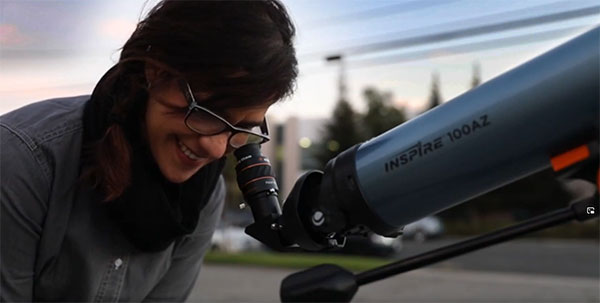
Here’s the recommended process to follow when you are shopping for a Barlow lens.
If you already have a telescope, make a list of the eyepieces you already own. If you are only planning to buy one, find out the size of the eyepieces that come bundled with it.
Next, calculate the focal lengths and magnification values you would have access to with Barlow lenses of different rates and compare them to the maximum and minimum magnification your telescope supports. These are generally listed in the telescope’s specifications, but if they are not, this telescope magnification chart can help.
Once you have selected the rate for the Barlow lens that better fits your situation, check out our guide on the best Barlow lenses where we have specific recommendations with reviews.
Let’s take a look at an example so all this is easier to understand.
Example: Let’s say you bought a mid-range Orion Spaceprobe 130 telescope that comes with two eyepieces: 25mm and 10mm. The highest useful magnification for this telescope is 260x, and the minimum is 19x according to the manufacturer. The focal length of the telescope is 650mm. This means we have access to the following magnifications with the included eyepieces
If you remember from earlier, the formula for magnification is as follows:
magnification = telescope focal length / eyepiece focal length
| 25mm eyepiece | 26x magnification |
| 10mm eyepiece | 65x magnification |
Since we know we can go between 19x and 260x, we can see there’s a lot of room to go up in magnification while our low magnification needs are already met as we are close enough to the minimum with the 26x we get from the 25mm eyepiece. This is a perfect case of when a Barlow lens can add lots of value.
Adding a single 2x Barlow lens to the mix, we now would have access to the following magnifications:
| 25mm eyepiece | 26x magnification |
| 25mm eyepiece + 2x Barlow | 52x magnification |
| 10mm eyepiece | 65x magnification |
| 10mm eyepiece + 2x Barlow | 130x magnification |
That covers a lot more ranges, but for lunar and planetary viewing we can probably still go higher. Let’s try a 3x Barlow.
| 25mm eyepiece | 26x magnification |
| 25mm eyepiece + 2x Barlow | 52x magnification |
| 25mm eyepiece + 3x Barlow | 78x magnification |
| 10mm eyepiece | 65x magnification |
| 10mm eyepiece + 2x Barlow | 130x magnification |
| 10mm eyepiece + 3x Barlow | 195x magnification |
Hmm…the 78x magnification is a bit too close to the 65x we are getting from the 10mm eyepiece alone. It wouldn’t make much of a difference there, so it seems like we would only purchase this to use it with the 10mm which doesn’t feel good.
Instead, let’s scratch that 3x Barlow and let’s consider adding another eyepiece, but since we are planning on getting the 2x Barlow, remember the value of every additional eyepieces we buy doubles as we get access to two new magnification values.
Let’s try a 6mm eyepiece.
| 25mm eyepiece | 26x magnification |
| 25mm eyepiece + 2x Barlow | 52x magnification |
| 10mm eyepiece | 65x magnification |
| 10mm eyepiece + 2x Barlow | 130x magnification |
| 6mm eyepiece | 108x magnification |
| 6mm eyepiece + 2x Barlow | 216x magnification |
Now we are talking. we have covered that large gap between the 65x and 130x magnification and we are much closer to our highest useful magnification of 260x.
So, in conclusion, for this telescope, it would be recommended to get a 2x Barlow lens and add a 6mm or even a 5mm eyepiece.
Enjoyed this article?
Get daily 10-minute PDFs about astronomy to read before bed!
Sign up for our upcoming micro-learning service where you will learn something new about space and beyond every day while winding down.


